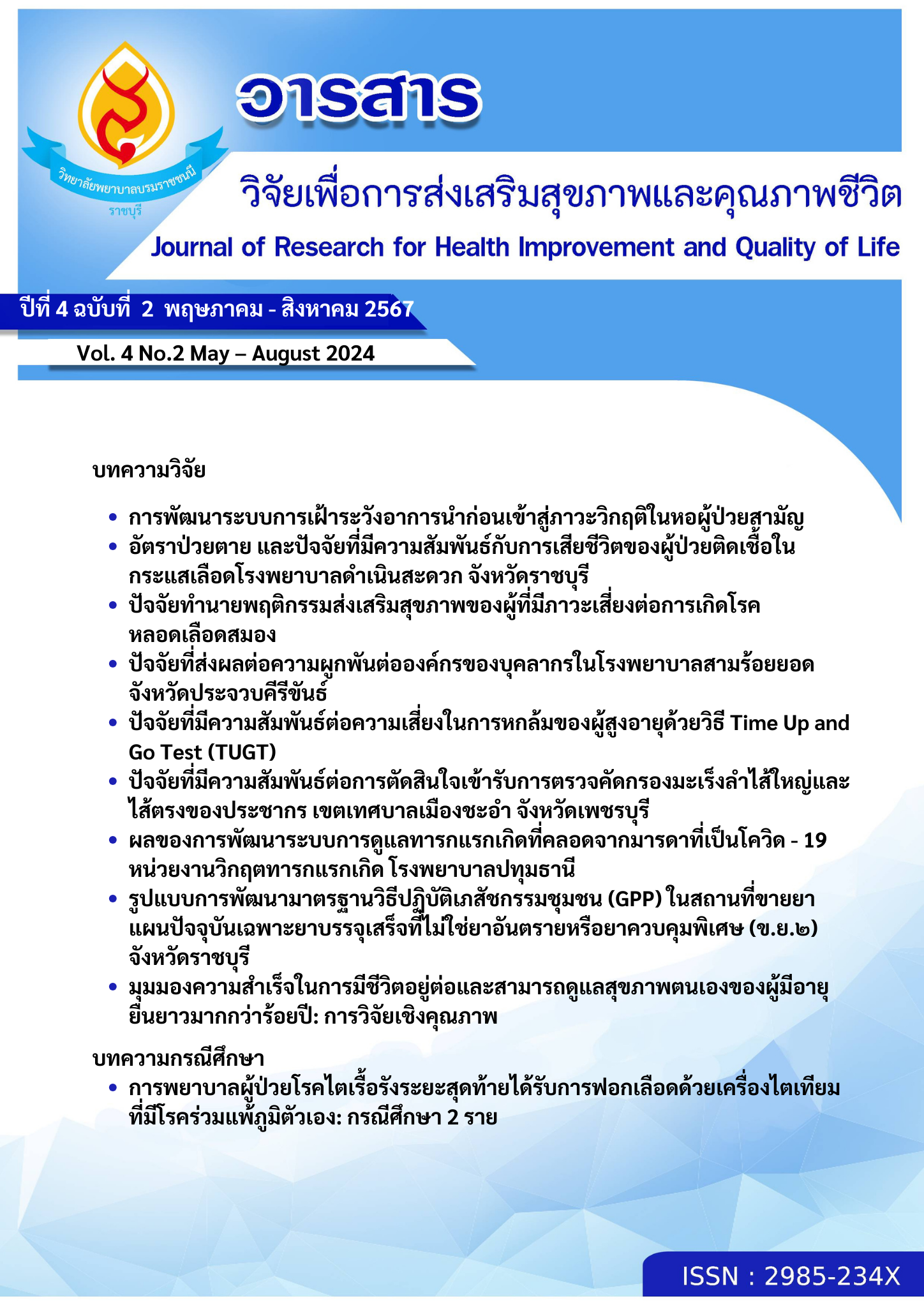ปัจจัยทำนายพฤติกรรมส่งเสริมสุขภาพของผู้ที่มีภาวะเสี่ยงต่อการเกิดโรคหลอดเลือดสมอง
คำสำคัญ:
ปัจจัยทำนาย , พฤติกรรมส่งเสริมสุขภาพ , ผู้ที่มีภาวะเสี่ยงต่อการเกิดโรคหลอดเลือดสมองบทคัดย่อ
การวิจัยเชิงทำนายนี้มีวัตถุประสงค์เพื่อศึกษาปัจจัยทำนายพฤติกรรมส่งเสริมสุขภาพของผู้ที่มีภาวะเสี่ยงต่อการเกิดโรคหลอดเลือดสมอง กลุ่มตัวอย่าง 321 ราย ได้จากวิธีการสุ่มกลุ่มตัวอย่างแบบหลายขั้นตอน เครื่องมือวิจัยประกอบด้วย 5 ส่วน คือแบบสอบถามข้อมูลทั่วไป แบบวัคความรู้เกี่ยวกับโรคหลอดเลือดสมอง แบบสอบถามการรับรู้โอกาสเสี่ยงของโรคหลอดเลือดสมองแบบสอบถามการรับรู้ประโยชน์ของการมีพฤติกรรมการป้องกันโรคหลอดเลือดสมอง และแบบสอบถามพฤติกรรมสร้างเสริมสุขภาพของผู้ที่มีภาวะเสี่ยงต่อการเกิดโรคหลอดเลือดสมองวิเคราะห์ข้อมูลโดยใช้สถิติเชิงพรรณนา และการวิเคราะห์ถดถอยพหุคูณแบบเพิ่มตัวแปรเป็นลำดับขั้น
ผลการวิจัย พบว่า ค่าเฉลี่ยของพฤติกรรมสร้างเสริมสุขภาพของผู้ที่มีภาวะเสี่ยงต่อการเกิดโรคหลอดเลือดสมองโดยรวม อยู่ในระดับพอใช้ (M =121.70, SD=18.34) ปัจจัย ได้แก่ อายุ การมีกิจกรรมทางกาย ความรู้เกี่ยวกับโรคหลอดเลือดสมอง และการรับรู้โอกาสเสี่ยงเกี่ยวกับโรคหลอดเลือดสมอง สามารถร่วมกันทำนายพฤติกรรมสร้างเสริมสุขภาพของผู้ที่มีภาวะเสี่ยงต่อการเกิดโรคหลอดเลือดสมองอย่างมีนัยสำคัญทางสถิติ ร้อยละ 28.0 (R2 = .280)
ดังนั้นบุคลากรทางด้านสุขภาพจึงควรนำปัจจัยที่สามารถทำนายพฤติกรรมสร้างเสริมสุขภาพของกลุ่ม ผู้ที่มีภาวะเสี่ยงต่อการเกิดโรคหลอดเลือดสมองไปใช้ในการออกแบบกิจกรรมปรับเปลี่ยนพฤติกรรมสร้างเสริมสุขภาพ เพื่อป้องกันการเกิดโรคหลอดเลือดสมองได้อย่างเหมาะสมต่อไป
เอกสารอ้างอิง
Becker, M. H., & Maiman, L. A. (1975). Sociobehavioral determinants of compliance with health and medical care recommendations. Medical care, 10-24.
Best, J. W. & Kahn, J. V. (2016). Research in education. Pearson Education India.
Brainin, M., Teuschl, Y., & Matz, K. (2014). Common risk factors and prevention. In M. Brainin, & W. D. Heiss (Eds.), Textbook of stroke medicine (pp.89-104). New York: Cambridge University Press.
Bloom, Benjamin S.J. (ed). (1975). Taxonomy of education objective, hand book 1: Cognitive Domain. New York: David Mckay.
Chareonsin, S., & Keeratisiroj, O. (2021). Factors affectings stroke prevention behavior in hypertension patients, Mueang District, Nakhon Sawan Province. (Master’s thesis). Phitsanulok: Naresuan University. (in Thai)
Cochran, W. G. (1997). Sampling techniques. 3rd ed New York: Wiley.
Department of Diseases Control, Ministry of Public Health. (2022). Stroke campaign 2023. https://ddc.moph.go.th/brc/news.php?news=37914&deptcode=brc&news_views=4383.
Inteng, B., & Chomson, S., (2019). Factors affecting stroke prevention behaviors of hypertensive patients of Muangkao Health Promotion Hospital, Phichit Province. EAU Heritage Journal Science and Technology, 13(1), 122-134. (in Thai)
Hair, J. F., Black, W. C., Babin, B. J., & Anderson, R. E. (2019). Multivariate data analysis (8th ed.). Boston: Cengage
Klinsakorn, C., & Saetan, S. (2020). Factors related to self-protective behavior of stroke with controlled hypertension patients who live in Danchang District, Suphanburi Province. Journal of Council of Community Public Health, 2(2), 62-77. (in Thai)
Lalun, A., & Vutiso, P. (2021). Factors predicting stroke behavior of hypertensive patients at Na Fai Sub-District Health Promoting Hospital in Chang Wat Chaiyaphum. Thai Journal of Nursing, 70(2), 27-36. (in Thai)
Mahakote,S., Khungtumneam, K., & Kompayak, J. (2019). Factors related health promoting behaviors in elderly people: A case study in a Crowded Community, Bangkok. Journal of Health and Nursing Research, 36(2), 225-233. (in Thai)
National Stroke Association. (2013). Stroke risk scorecard.
http://www.stroke.org/sites/default/files/resources/RiskStrokeScorecard_Eng.pdf
Oh, J. (2021). Factors affecting health promoting behavior among older women in Korea: a structural equation model. Health Promotion International, 36(4), 924-932.
Panwilai, J., Soivong, P., & Somrarnyart, M. (2018). Health promoting behaviors among persons at risk of stroke. Nursing Journal, 45(2), 14-27. (in Thai)
Pattaradech, C. (2016). Predictors of exercise behavior among older adults in Songkhla Province. The Southern College Network Journal of Nursing and Public Health, 3(2),17-38. (in Thai)
Pender, N.J., Murdaugh, C.L., & Parsons, M.A. (2006). Health promotion in nursing practice (5th ed.). New Jersey: Pearson Prentice Hall.
Pender, N. J., Murdaugh, C. L., & Parsons, M. A. (2014). Health promotion in nursing practice (7th edition).
Pesungnoen, A., Suwonroop, N., & Pinyopasakul, W. (2018). Factors predicting stroke prevention behaviors in patients at risk in primary care units. The Journal of Boromarajonani College of Nursing Nakhonratchasima. 24(1), 40-56. (in Thai)
Ruangchaithaweesuk, K., Wongpiriyayothar, A., & Wongpanarak, N. (2020). Factors predicting stroke prevention behaviors in patients at risk of stroke. Thai Red Cross Nursing Journal, 14(1), 213-225. (in Thai)
Sanaati, F., Geranmayeh, M., Behboodi Moghadam, Z., Zareiyan, A., Samadaee Gelehkolaee, K., & Mirghafourvand, M. (2021). A population-based study of health-promoting behaviors and their predictors in Iranian males, 2019. Archives of Public Health, 79, 1-7.
Sodaprom D & Wanaratwichit C. (2021). Factors influencing preventive behaviors for cerebrovascular disease among elderly risk group in The Aranyik Tow Municipality Mueang Phitsanulok District Phitsanulok Province. Journal of Phrapokkloa Nursing College, Chanthaburi, 32(2), 98-111. (in Thai)
Watcharanurak, P., & Klubklay, A. (2017). Factors influencing preventive behavior among stoke-risk patients in Songkhla Province. The Southern College Network Journal of Nursing and Public Health, 4(1), 217-233. (in Thai)
Wongchana H. (2021). Factors affectings to preventive behavior of stroke patients among uncontrolled- hypertensive in Mueang District, Phitsanulok Province. (Master’s thesis). Phitsanulok: Naresuan University. (in Thai)
World Stroke Organization. (2022). The top 10 causes of death. 21 February 2022. https://www.who.int/news-room/fact-sheets/detail/the-top-10-causes-of-death#.YhJBDX oc8HO.
ดาวน์โหลด
เผยแพร่แล้ว
ฉบับ
ประเภทบทความ
สัญญาอนุญาต
ลิขสิทธิ์ (c) 2024 วิทยาลัยพยาบาลบรมราชชนนี ราชบุรี

อนุญาตภายใต้เงื่อนไข Creative Commons Attribution-NonCommercial-NoDerivatives 4.0 International License.
บทความทีตีพิมพ์ในวารสารนี้ถือว่าเป็นลิขสิทธิ์ของวิทยาลัยพยาบาลบรมราชชนนี ราชบุรี และผลงานวิชาการหรือวิจัยของคณะผู้เขียน ไม่ใช่ความคิดเห็นของบรรณาธิการหรือผู้จัดทํา




